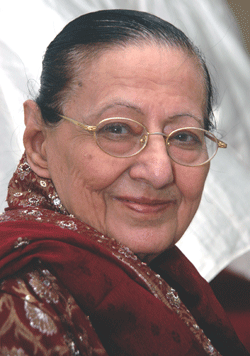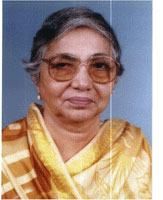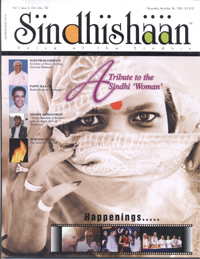Sindhi Women Writers
on Sindhi Women
by - Rita Shahani

Is it possible to create a literary master-piece in the absence of a woman?
We all know that the entire earth is firmly fixed on two powerful pillars of the two genders i.e. — Woman and Man, They have been creating and recreating the world together since time immemorial. The man is the seed and the woman is fertile earth. Not only human society but, all species — birds and beasts, flowers, trees and plants have two genders. Both sexes have equal responsibility and equal importance. Then how is it that both of them do not enjoy the same status and position in their homes and society? There is something drastically wrong in the balance of scale. Is it due to the physical strength of the man? It can’t be so, because we know that in ancient-Vedic-era women had freedom of thought and speech. The women scholars and poetesses like Gargi, Maitriya and Vachch, were able to sit side by side in the royal courts with great sages and scholars and discuss matters on religion and philosophy. I do not want to get into the historical details, as we are all aware of the deteriorating process, which took place in the lives of women, specially after the foreign invasions.
Women may have taken a back seat in social, educational and domestic fields and they were no doubt victimised by men for centuries but so far as literature is concerned they have a safe and secure place in the literary world of great writers and poets. Writers have not been able to ignore them. How could they? From Valmiki to Ved Vyas, from Kalidas to Shakespeare all writers have put them on high pedestals. Is it possible to create a literary master-piece in the absence of a woman? Sita, Kaikayi, Radha, Yashoda, Dropadi, Shakuntala, Cleopatra and Ephelia, added flavour and beauty and played important roles in their stories. Poets and writers have depicted mother’s love, woman’s love, her sacrifices and patience, dedication and devotion and other qualities of a woman. Through the roles of mother, daughter, sister and beloved, women have been showering fountains of rainbow colours of subtle beauty and glamour to the literature of yester years.
But literature is also the mirror of life and society. In real life, women were chained to their homes and hearths and were treated as slaves throughout the world till the last century. Hence, there was no question of their emerging as writers and poetesses (barring few exceptions of Mira bai of Rajasthan of the 15th century and Zebunissa of Moghul dynasty, both of them from royal families). Women could not express themselves through their quills. Towards the end of the nineteenth century three Bronte sisters - Charlette, Emily and Anne of England had written novels under fictitious male names, to avoid defame and contempt of the prevailing Society.
Women writers throughout the world have come up only in the beginning of the 20th century. In Sindhi literature, the first bold lady writer, who wrote a novel ‘Itihad’ in which the Hindu heroine falls in love with a Muslim boy and marries him, despite all the opposition was Guli Sadarangani, who paved the way for Sindhi lady writers. The process had to start somewhere, sometime.
Popati has a knack of using her Boli (language) as a Goli (Bullet)

Popati Hiranandani is a writer with the fighter’s spirit. We can sense the fighting spirit in her novels, stories, essays and poems. She came into full form after the partition of India. She revolts against the male dominated society, against male atrocities towards their women counterparts, down century’s lane to the present time. In Professor Hiro Shewkani’s words, “her vow to become a writer inspite of being a woman has blossomed and made her personality beautiful. Her struggle to avail herself and entire women community of equal women’s rights same as men has kept her war going on and on ….”
Each fibre of Popati’s being is vibrant for the well being of a woman. She cannot tolerate injustice. She goes deep into the emotional, psychological, physical and intellectual aspects of a woman’s very being. She fully understands her hopes, desires, expectations, love, maternal feelings and ideals. When men don’t understand them, they don’t appreciate their emotions, they deceive them, use them or ill-treat them Popati revolts through the characters of her stories.
In Hari Dilgir’s words, ‘Popati has a knack of using her Boli (language) as a Goli (Bullet)’. Yes Popati’s pen has a power to pierce the heart of her readers, by revealing the pain of a woman’s heart.
Popati’s poem ‘Dhuna hethan Dubili’ (a box under the belly button) caused a great furore in the Sindhi Literary world when it was first published, for being too open and frank as it expressed her liberated ideas. The poem is about the role played by a woman’s physical organ — uterus in male and female lives.
Now, my ideals are taking up all my time and energy. Now, perhaps, I shall have to abandon my husband for my ideals.

Sundari Uttamchandani, another senior Sindhi writer’s style of ‘women’ in her stories is totally different. Most of her characters are emotional, mild, soft and delicate. Her language is poetic with original pure Sindhi accent. The background of her stories is urban, middle class Sindhi social circle. Some of her stories have progressive touch, depicting poverty, disease and despair. Most of her female characters are weak and helpless. There is lot of variety of female characters in her stories, which deal with domestic problems. Mother-in-law and sister-in-law jealousies, quarrels, small arguments and differences in domestic lives. But two of her characters, ‘Bhuri’ and ‘Amuli’ have shown courage and spirit and have attracted my attention. She has presented in her subtle and lucid manner ‘Bhuri’ and ‘Amuli’ of the same titled stories. Bhuri belongs to that pro-partition days when a refugee woman makes the sale of ‘Papads’ and ‘Vadis’ as her livelihood. When she goes to her ex lover’s house his wife finds a glow on her face, which was not of a physical nature but a spiritual one. The aura was reflecting the self-confidence and self -supportiveness, which she had gained because of the hardships of life. ‘Amuli’ is a modern woman, whose husband, so called idealist, leaves her and their child saying that he did not want to waste his life’s dream for an ordinary life partner. In his absence Amuli spreads her wings and develops her personality, teaching and training teachers. She is extremely occupied when her husband eventually comes back and settles down with her. But it is not the same again. When he screams, “Who would call this home? Cobwebs all over the place?” She retorted, “when you had abandoned me for your ideals, my whole mind, my world was covered with cobwebs. Now, my ideals are taking up all my time and energy. Now, perhaps, I shall have to abandon my husband for my ideals.
Going through dozens of stories of a particular writer (man or woman) at one time, I have observed that one main and the same character emerges from nearly all the stories of the same writer, which reflects the character, the nature and characteristics of the writer himself/herself. Popati’s main characters are like her - bold and brave. In the same way Sundri’s own image reflects in her stories and so on and so forth. This theory is applicable to male writers also. It is not that they do not and cannot create other types of characters. They do, but the focal character comes out unconsciously without their knowledge in their writings, which is similar to the character, personality, temperament and ideology.
Her heroines suffer a lot at the hands of their lovers, but they do not rebel. They suffer quietly and carry the burden of their grief alone.
Tara Mirchandani’s female characters are mild, loving, sweet, emotional and gullible. They love intensely and put all their trust and faith blindly in their lovers, who turn out to be fake lovers and scoundrels. In some of her stories, they cheat them and rob them of their youth, virginity and property as well. Tara tells us about the cunningness and infidelity of men. Her heroines suffer a lot at the hands of their lovers, but they do not rebel. They suffer quietly and carry the burden of their grief alone.
Bhavana of her story ‘Bhavana’ is a real artist. Acting is a passion with her. Though she is emotionally and physically weak, she has moral courage to leave her home and husband, who doesn’t allow her to act due to her ill health. She leaves him and prefers to live in a flat alone, to pursue her artistic instincts. She successfully plays the role and is able to convince her husband to let her carry on with her acting.

In Kala Prakash’s stories we find the working women working in the offices of big metros of India. She tells us about the mental tensions and turmoils of working class women. How men make passes at them and demand something in return for the small favours bestowed on them. In two of her stories, ‘Hawa jo jhonko’ and ‘Parao Vanhvar’ strong tendency of men to have extra marital relationships is shown. Her poem ‘Mamta joon Lahroon’ was an acclaimed poem of her time.
Indira Vaswani has also touched the subject of life and problems of urban working women. Her story ‘Nalo’ is one of those stories. In ‘Faqiryani’ there is a portrayal of a dirty, filthy, beggar woman, who delivers a baby on the roadside. In that story she has portrayed the physiological structure of a woman’s body.
 Rita Shahani has raised her voice and shown duplicity, disloyalty and multigamous nature of man in her stories ‘Mard re Mard’, ‘Uha raat’, ‘Saheri chho Bhagi’ and ‘Guftagoo’. Her female characters revolt against injustice meted out to them by men. She has also touched the subject of most heinous and cruel crime committed by men in the shape of RAPE in her story ‘Amen’ and novel ‘Goonge Gagan saan guftagoo’. How the lives of those girls are mired with the stigma and traumatic experience faced by them for no fault of theirs. She has shown weaknesses and follies of both the sexes in her stories.
Rita Shahani has raised her voice and shown duplicity, disloyalty and multigamous nature of man in her stories ‘Mard re Mard’, ‘Uha raat’, ‘Saheri chho Bhagi’ and ‘Guftagoo’. Her female characters revolt against injustice meted out to them by men. She has also touched the subject of most heinous and cruel crime committed by men in the shape of RAPE in her story ‘Amen’ and novel ‘Goonge Gagan saan guftagoo’. How the lives of those girls are mired with the stigma and traumatic experience faced by them for no fault of theirs. She has shown weaknesses and follies of both the sexes in her stories.
Maya Rahi, in her story ‘Hiro’ reveals women’s weakness, their benevolent nature of giving away all their earnings and savings to their menfolk unhesitatingly and in most cases being the losers in the end. In above mentioned story, the heroine realises her mistake and refuses to sign the blank cheque offered by her husband. She bravely puts a stop to her practice of many years of signing cheques without asking questions. Her husband is shocked by the sudden change in her behaviour.
Dr. Yashodhara Wadhwani, has given vent to the feelings of anguish, despair and revolt of a woman’s heart by comparing her with Indian musical instruments, such as Bansuri (flute), Sarangi (a kind of harp) and Bheri (trumpet) respectively. For instance assuming herself first as a flute, she says
‘Why did they give me pain, by piercing holes in my body?
Why did they blow the puffs of mild air into my interiors already dried of all its sap?
To top it, they kept pretending of kissing me with their lips!
On the other hand, signaling me with their fingers to keep mum.’
Yashodhra has also condemned the deplorable practice of female foetocide through her story ‘ultra-sonography’ where women themselves destroy their daughter before they are born, under the pressure of husbands, in-laws and society.

Indira Poonawala expresses her fury in a subtle manner, in her satirical poem ‘Bijli Bathi’. She has portrayed the feelings of an old fashioned father who writes in his Will that his body should not be given away to the flames of electric crematorium, as that would deprive him of benefit of going to heaven after his death. He firmly believes that the gates of heaven will only open if his son lights his funeral pyre. Did he not destroy many female foetices and married again and again to get a ‘putra ratan’ for that purpose?
This work will be incomplete if the mention of Sind Pakistan’s feminist writer Atiya Dawood is not made. She is not only a poetess but an activist, where women rights are concerned and goes out of her way to help them in their real lives. She is full of rage at the cruel, insulting and humiliating manner in which women are treated by men. She is justifiably furious at the ‘Karo-Kari’ custom prevalent in Sind even today when a woman is murdered instantly by her husband, if she is said to be unfaithful (proved or unproved). Husband can have as many affairs or wives as he likes, but a woman cannot dare to look at another man. The custom of ‘Karo-Kari’ is accepted by the laws of her country. If the husband kills his wife on that plea, he will not be punished legally at all. And men are taking undue advantage by destroying their wives under false pretext.
She addresses her daughter in her poem ‘My daughter’ in her book ‘Raging to be free’
Even they brand you a Kari,
And condemn you to death,
then choose death, but live to love.
don’t sit pretty in the showcase of respectability
you must live to love.
Dr. Kamla Goklani & Veena Shringi
have also depicted women suffering in their stories and poems.
We can clearly see the change of tone in the expression of Sindhi women writer’s work. They no longer hesitate to express their sweet romantic thoughts and emotions nor do they try to curb the feelings of revolt. Popati’s revolt, Indira’s anger, Yashodhara’s challenge, Atiya’s fury and feelings of revenge, Sundri’s pain emerges from the depths of their heart knowingly and unknowingly with spontaneous flow, because woman’s pain is embedded in every fibre of her being.


